Projection of Future Meteorological Droughts in Lake Urmia Basin, Iran
Abstract
:1. Introduction
2. Materials and Methods
2.1. Datasets
- (1)
- The daily precipitation data taken from 7 synoptic stations from 1986–2014 were provided by the Iran Meteorological Organization (IRIMO) (Table 1, Figure 1). These datasets form the measured synoptic dataset for Iran (www.data.irimo.ir) (accessed on 10 May 2017).
- (2)
- The precipitation dataset of the GCMs from CMIP6 for the historical reference (1950–2014) and future (2015–2100) periods were obtained from the NASA Earth Exchange Global Daily Downscaled Projections (NEX-GDDP) (accessed on 22 November 2022, https://registry.opendata.aws/nex-gddp-cmip6/).
2.2. Methods
2.3. Drought Indices
2.4. Evaluation of Model Performance
3. Results
4. Discussion
5. Conclusions
Supplementary Materials
Author Contributions
Funding
Data Availability Statement
Acknowledgments
Conflicts of Interest
References
- Yang, T.-H.; Liu, W.-C. A general overview of the risk-reduction strategies for floods and droughts. Sustainability 2020, 12, 2687. [Google Scholar] [CrossRef]
- Frischen, J.; Meza, I.; Rupp, D.; Wietler, K.; Hagenlocher, M. Drought risk to agricultural systems in Zimbabwe: A spatial analysis of hazard, exposure, and vulnerability. Sustainability 2020, 12, 752. [Google Scholar] [CrossRef]
- Haghighi, A.H.; Zaki, N.A.; Rossi, P.M.; Noori, R.; Hekmatzadeh, A.A.; Saremi, H.; Kløve, B. Unsustainability Syndrome—From Meteorological to Agricultural Drought in Arid and Semi-Arid Regions. Water 2020, 12, 838. [Google Scholar] [CrossRef]
- Trenberth, K.E.; Fasullo, J.T.; Shepherd, T.G. Attribution of climate extreme events. Nat. Clim. Chang. 2015, 5, 725–730. [Google Scholar] [CrossRef]
- Schwabe, K.; Albiac, J.; Connor, J.D.; Hassan, R.M.; González, L.M. Drought in Arid and Semi-Arid Regions: A Multi-Disciplinary and Cross-Country Perspective; Springer: Berlin/Heidelberg, Germany, 2013. [Google Scholar]
- Nafarzadegan, A.; Zadeh, M.R.; Kherad, M.; Ahani, H.; Gharehkhani, A.; Karampoor, M.; Kousari, M. Drought area monitoring during the past three decades in Fars province, Iran. Quat. Int. 2012, 250, 27–36. [Google Scholar] [CrossRef]
- Wilhite, D.A.; Glantz, M.H. Understanding: The drought phenomenon: The role of definitions. Water Int. 1985, 10, 111–120. [Google Scholar] [CrossRef]
- Heim, R.R., Jr. A review of twentieth-century drought indices used in the United States. Bull. Am. Meteorol. Soc. 2002, 83, 1149–1166. [Google Scholar] [CrossRef]
- Mishra, A.K.; Singh, V.P. A review of drought concepts. J. Hydrol. 2010, 391, 202–216. [Google Scholar]
- Guttman, N.B. Comparing the palmer drought index and the standardized precipitation index. JAWRA J. Am. Water Resour. Assoc. 1998, 34, 113–121. [Google Scholar] [CrossRef]
- Stagge, J.H.; Tallaksen, L.M.; Gudmundsson, L.; Van Loon, A.F.; Stahl, K. Candidate distributions for climatological drought indices (SPI and SPEI). Int. J. Climatol. 2015, 35, 4027–4040. [Google Scholar] [CrossRef]
- McKee, T.B.; Doesken, N.J.; Kleist, J. The relationship of drought frequency and duration to time scales. In Proceedings of the 8th Conference on Applied Climatology, Anaheim, CA, USA, 17–22 January 1993; pp. 179–183. [Google Scholar]
- Wu, J.; Liu, Z.; Yao, H.; Chen, X.; Chen, X.; Zheng, Y.; He, Y. Impacts of reservoir operations on multi-scale correlations between hydrological drought and meteorological drought. J. Hydrol. 2018, 563, 726–736. [Google Scholar] [CrossRef]
- Svoboda, M.; Hayes, M.; Wood, D. Standardized Precipitation Index: User Guide; World Meteworological Organization: Geneva, Switzerland, 2012. [Google Scholar]
- Rouault, M.; Richard, Y. Intensity and spatial extension of drought in South Africa at different time scales. Water Sa 2003, 29, 489–500. [Google Scholar] [CrossRef]
- Irannezhad, M.; Haghighi, A.T.; Chen, D.; Kløve, B. Variability in dryness and wetness in central Finland and the role of teleconnection patterns. Theor. Appl. Climatol. 2015, 122, 471–486. [Google Scholar] [CrossRef]
- Mehr, A.D.; Sorman, A.U.; Kahya, E.; Afshar, M.H. Climate change impacts on meteorological drought using SPI and SPEI: Case study of Ankara, Turkey. Hydrol. Sci. J. 2020, 65, 254–268. [Google Scholar] [CrossRef]
- Moccia, B.; Mineo, C.; Ridolfi, E.; Russo, F.; Napolitano, F. SPI-Based Drought Classification in Italy: Influence of Different Probability Distribution Functions. Water 2022, 14, 3668. [Google Scholar] [CrossRef]
- Keyantash, J.; Dracup, J.A. The quantification of drought: An evaluation of drought indices. Bull. Am. Meteorol. Soc. 2002, 83, 1167–1180. [Google Scholar] [CrossRef]
- Daneshvar, M.R.M.; Ebrahimi, M.; Nejadsoleymani, H. An overview of climate change in Iran: Facts and statistics. Environ. Syst. Res. 2019, 8, 7. [Google Scholar] [CrossRef]
- Haghighi, A.T.; Fazel, N.; Hekmatzadeh, A.A.; Klöve, B. Analysis of effective environmental flow release strategies for Lake Urmia restoration. Water Resour. Manag. 2018, 32, 3595–3609. [Google Scholar] [CrossRef]
- Ashraf, S.; AghaKouchak, A.; Nazemi, A.; Mirchi, A.; Sadegh, M.; Moftakhari, H.R.; Hassanzadeh, E.; Miao, C.-Y.; Madani, K.; Baygi, M.M.; et al. Compounding effects of human activities and climatic changes on surface water availability in Iran. Clim. Chang. 2019, 152, 379–391. [Google Scholar] [CrossRef]
- Ashraf, S.; Nazemi, A.; AghaKouchak, A. Anthropogenic drought dominates groundwater depletion in Iran. Sci. Rep. 2021, 11, 9135. [Google Scholar] [CrossRef]
- Vaghefi, S.A.; Keykhai, M.; Jahanbakhshi, F.; Sheikholeslami, J.; Ahmadi, A.; Yang, H.; Abbaspour, K.C. The future of extreme climate in Iran. Sci. Rep. 2019, 9, 1464. [Google Scholar] [CrossRef] [PubMed]
- Zeydalinejad, N.; Nassery, H.R. A review on the climate-induced depletion of Iran’s aquifers. Stoch. Environ. Res. Risk Assess. 2022, 37, 467–490. [Google Scholar] [CrossRef]
- Wurtsbaugh, W.A.; Miller, C.; Null, S.E.; DeRose, R.J.; Wilcock, P.; Hahnenberger, M.; Howe, F.; Moore, J. Decline of the world’s saline lakes. Nat. Geosci. 2017, 10, 816–821. [Google Scholar] [CrossRef]
- Hassanzadeh, E.; Zarghami, M.; Hassanzadeh, Y. Determining the main factors in declining the Urmia Lake level by using system dynamics modeling. Water Resour. Manag. 2012, 26, 129–145. [Google Scholar] [CrossRef]
- AghaKouchak, A.; Norouzi, H.; Madani, K.; Mirchi, A.; Azarderakhsh, M.; Nazemi, A.; Nasrollahi, N.; Farahmand, A.; Mehran, A.; Hasanzadeh, E. Aral Sea syndrome desiccates Lake Urmia: Call for action. J. Great Lakes Res. 2015, 41, 307–311. [Google Scholar] [CrossRef]
- Khazaei, B.; Khatami, S.; Alemohammad, S.H.; Rashidi, L.; Wu, C.; Madani, K.; Kalantari, Z.; Destouni, G.; Aghakouchak, A. Climatic or regionally induced by humans? Tracing hydro-climatic and land-use changes to better understand the Lake Urmia tragedy. J. Hydrol. 2019, 569, 203–217. [Google Scholar] [CrossRef]
- Taylor, K.E.; Stouffer, R.J.; Meehl, G.A. An overview of CMIP5 and the experiment design. Bull. Am. Meteorol. Soc. 2012, 93, 485–498. [Google Scholar] [CrossRef]
- Rahimi, M.; Mohammadian, N.; Vanashi, A.R.; Whan, K. Trends in indices of extreme temperature and precipitation in iran over the period 1960–2014. Open J. Ecol. 2018, 8, 396. [Google Scholar] [CrossRef]
- Ghazi, B.; Jeihouni, E.; Kouzehgar, K.; Haghighi, A.T. Assessment of probable groundwater changes under representative concentration pathway (RCP) scenarios through the wavelet–GEP model. Environ. Earth Sci. 2021, 80, 446. [Google Scholar] [CrossRef]
- Jeihouni, E.; Mohammadi, M.; Ghazi, B. Response of the Shabestar Plain aquifer to climate-change scenarios through statistical and hybrid soft computing techniques. Groundw. Sustain. Dev. 2021, 15, 100649. [Google Scholar] [CrossRef]
- Zeydalinejad, N.; Nassery, H.R.; Alijani, F.; Shakiba, A.; Ghazi, B. A Proposed Approach towards Quantifying the Resilience of Water Systems to the Potential Climate Change in the Lali Region, Southwest Iran. Climate 2022, 10, 182. [Google Scholar] [CrossRef]
- Abbasi, A.; Khalili, K.; Behmanesh, J.; Shirzad, A. Drought monitoring and prediction using SPEI index and gene expression programming model in the west of Urmia Lake. Theor. Appl. Climatol. 2019, 138, 553–567. [Google Scholar] [CrossRef]
- Ebrahimpour, E.; Aminnejad, B.; Khalili, K. Assessing future drought conditions under a changing climate: A case study of the Lake Urmia basin in Iran. Water Supply 2019, 19, 1851–1861. [Google Scholar] [CrossRef]
- Mirgol, B.; Nazari, M.; Etedali, H.R.; Zamanian, K. Past and future drought trends, duration, and frequency in the semi-arid Urmia Lake Basin under a changing climate. Meteorol. Appl. 2021, 28, e2009. [Google Scholar] [CrossRef]
- Mauritsen, T.; Bader, J.; Becker, T.; Behrens, J.; Bittner, M.; Brokopf, R.; Brovkin, V.; Claussen, M.; Crueger, T.; Esch, M.; et al. Developments in the MPI-M Earth System Model version 1.2 (MPI-ESM1. 2) and its response to increasing CO2. J. Adv. Model. Earth Syst. 2019, 11, 998–1038. [Google Scholar] [CrossRef] [PubMed]
- Eyring, V.; Bony, S.; Meehl, G.A.; Senior, C.A.; Stevens, B.; Stouffer, R.J.; Taylor, K.E. Overview of the Coupled Model Intercomparison Project Phase 6 (CMIP6) experimental design and organization. Geosci. Model Dev. 2016, 9, 1937–1958. [Google Scholar] [CrossRef]
- Hagedorn, R.; Doblas-Reyes, F.J.; Palmer, T.N. The rationale behind the success of multi-model ensembles in seasonal forecasting—I. Basic concept. Tellus A Dyn. Meteorol. Oceanogr. 2005, 57, 219–233. [Google Scholar]
- Parsons, L.A.; Amrhein, D.E.; Sanchez, S.C.; Tardif, R.; Brennan, M.K.; Hakim, G.J. Do Multi-Model Ensembles Improve Reconstruction Skill in Paleoclimate Data Assimilation? Earth Space Sci. 2021, 8, e2020EA001467. [Google Scholar] [CrossRef]
- Abbasian, M.S.; Abrishamchi, A.; Najafi, M.R.; Moghim, S. Multi-site statistical downscaling of precipitation using generalized hierarchical linear models: A case study of the imperilled Lake Urmia basin. Hydrol. Sci. J. 2020, 65, 2466–2481. [Google Scholar] [CrossRef]
- Ghazi, B.; Jeihouni, E. Projection of temperature and precipitation under climate change in Tabriz, Iran. Arab. J. Geosci. 2022, 15, 621. [Google Scholar] [CrossRef]
- Abbasian, M.S.; Najafi, M.R.; Abrishamchi, A. Increasing risk of meteorological drought in the Lake Urmia basin under climate change: Introducing the precipitation–temperature deciles index. J. Hydrol. 2021, 592, 125586. [Google Scholar] [CrossRef]
- Gurney, K.R.; Kılkış, Ş.; Seto, K.C.; Lwasa, S.; Moran, D.; Riahi, K.; Keller, M.; Rayner, P.; Luqman, M. Greenhouse gas emissions from global cities under SSP/RCP scenarios, 1990 to 2100. Glob. Environ. Chang. 2022, 73, 102478. [Google Scholar] [CrossRef]
- Thrasher, B.; Wang, W.; Michaelis, A.; Melton, F.; Lee, T.; Nemani, R. NASA Global Daily Downscaled Projections, CMIP6. Sci. Data 2022, 9, 262. [Google Scholar] [CrossRef]
- Thrasher, B.; Wang, W.; Michaelis, A.; Nemani, R. NEX-GDDP-CMIP6; NASA Center for Climate Simulation: Greenbelt, MD, USA, 2021. [CrossRef]
- Thrasher, B.; Maurer, E.P.; McKellar, C.; Duffy, P.B. Bias correcting climate model simulated daily temperature extremes with quantile mapping. Hydrol. Earth Syst. Sci. 2012, 16, 3309–3314. [Google Scholar] [CrossRef]
- Park, T.; Hashimoto, H.; Wang, W.; Thrasher, B.; Michaelis, A.R.; Lee, T.; Brosnan, I.G.; Nemani, R.R. What does global land climate look like at 2 degrees warming? Earth’s Future 2022, e2022EF003330. [Google Scholar] [CrossRef]
- Zheng, X.; Ma, Q.; Wang, Y.; Wang, X.; Zhang, X.; Luan, Q. Assessing Impact of Temperature Variability of Climate Change on Mortality Based on Multiple GCM Projections in China. Atmosphere 2022, 13, 1775. [Google Scholar] [CrossRef]
- Guga, S.; Ma, Y.; Riao, D.; Zhi, F.; Xu, J.; Zhang, J. Drought monitoring of sugarcane and dynamic variation characteristics under global warming: A case study of Guangxi, China. Agric. Water Manag. 2023, 275, 108035. [Google Scholar] [CrossRef]
- Vicente-Serrano, S.M.; Beguería, S.; López-Moreno, J.I. A multiscalar drought index sensitive to global warming: The standardized precipitation evapotranspiration index. J. Clim. 2010, 23, 1696–1718. [Google Scholar] [CrossRef]
- An, S.; Park, G.; Jung, H.; Jang, D. Assessment of future drought index using SSP scenario in Rep. of Korea. Sustainability 2022, 14, 4252. [Google Scholar] [CrossRef]
- Ayugi, B.; Shilenje, Z.W.; Babaousmail, H.; Sian, K.T.L.M.; Mumo, R.; Dike, V.N.; Iyakaremye, V.; Chehbouni, A.; Ongoma, V. Projected changes in meteorological drought over East Africa inferred from bias-adjusted CMIP6 models. Nat. Hazards 2022, 113, 1151–1176. [Google Scholar]
- Zeng, J.; Li, J.; Lu, X.; Wei, Z.; Shangguan, W.; Zhang, S.; Dai, Y.; Zhang, S. Assessment of global meteorological, hydrological and agricultural drought under future warming based on CMIP6. Atmos. Ocean. Sci. Lett. 2022, 15, 100143. [Google Scholar] [CrossRef]
- Gleckler, P.J.; Taylor, K.E.; Doutriaux, C. Performance metrics for climate models. J. Geophys. Res. Atmos. 2008, 113. [Google Scholar] [CrossRef]
- Schoof, J.T.; Pryor, S. Downscaling temperature and precipitation: A comparison of regression-based methods and artificial neural networks. Int. J. Climatol. A J. R. Meteorol. Soc. 2001, 21, 773–790. [Google Scholar] [CrossRef]
- Davarpanah, S.; Erfanian, M.; Javan, K. Assessment of climate change impacts on drought and wet spells in Lake Urmia Basin. Pure Appl. Geophys. 2021, 178, 545–563. [Google Scholar] [CrossRef]
- Lloyd-Hughes, B.; Saunders, M.A. A drought climatology for Europe. Int. J. Climatol. A J. R. Meteorol. Soc. 2002, 22, 1571–1592. [Google Scholar] [CrossRef]
- McKee, T.B. Drought monitoring with multiple time scales. Proceedings of 9th Conference on Applied Climatology, Boston; 1995. [Google Scholar]

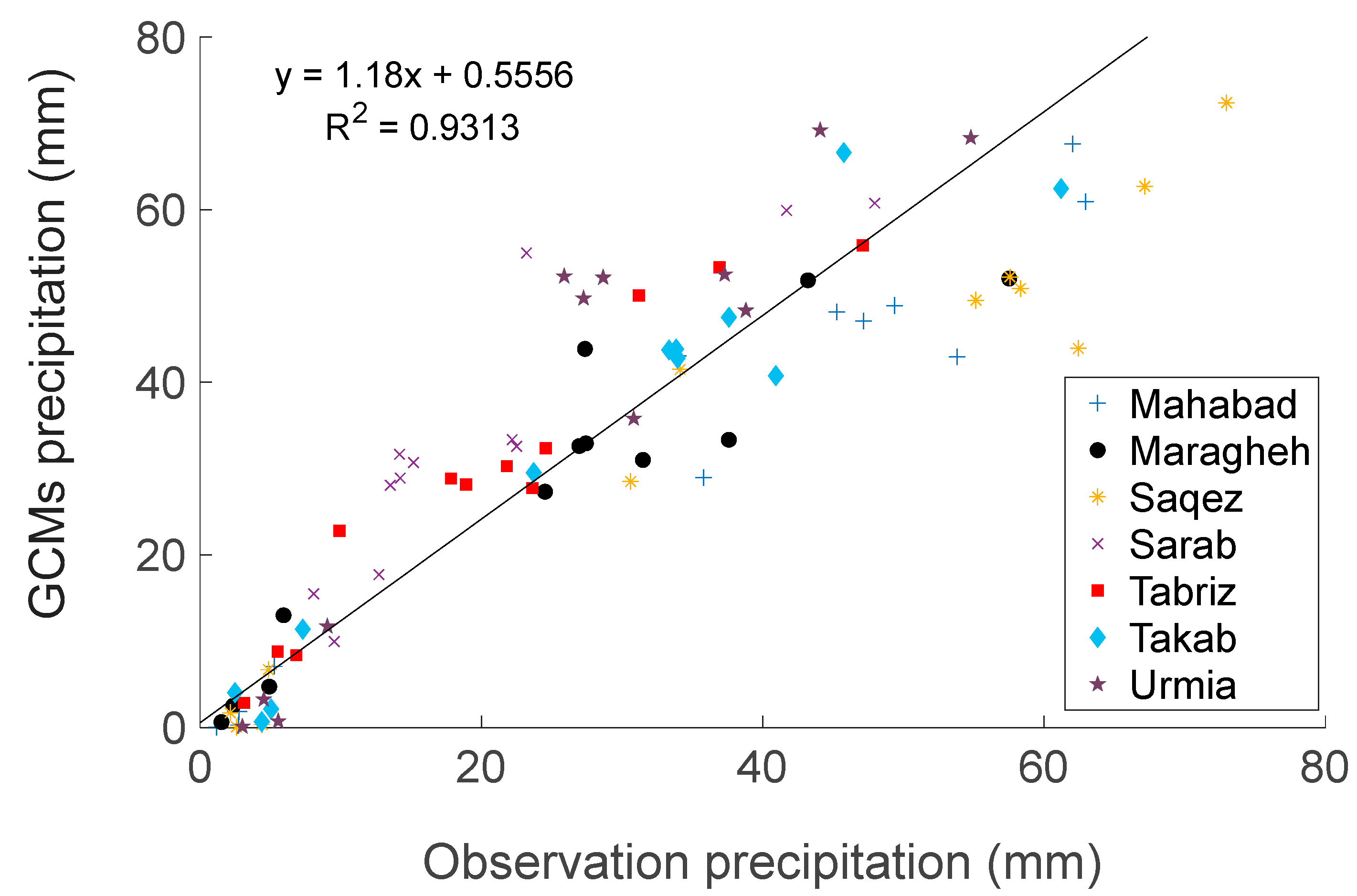
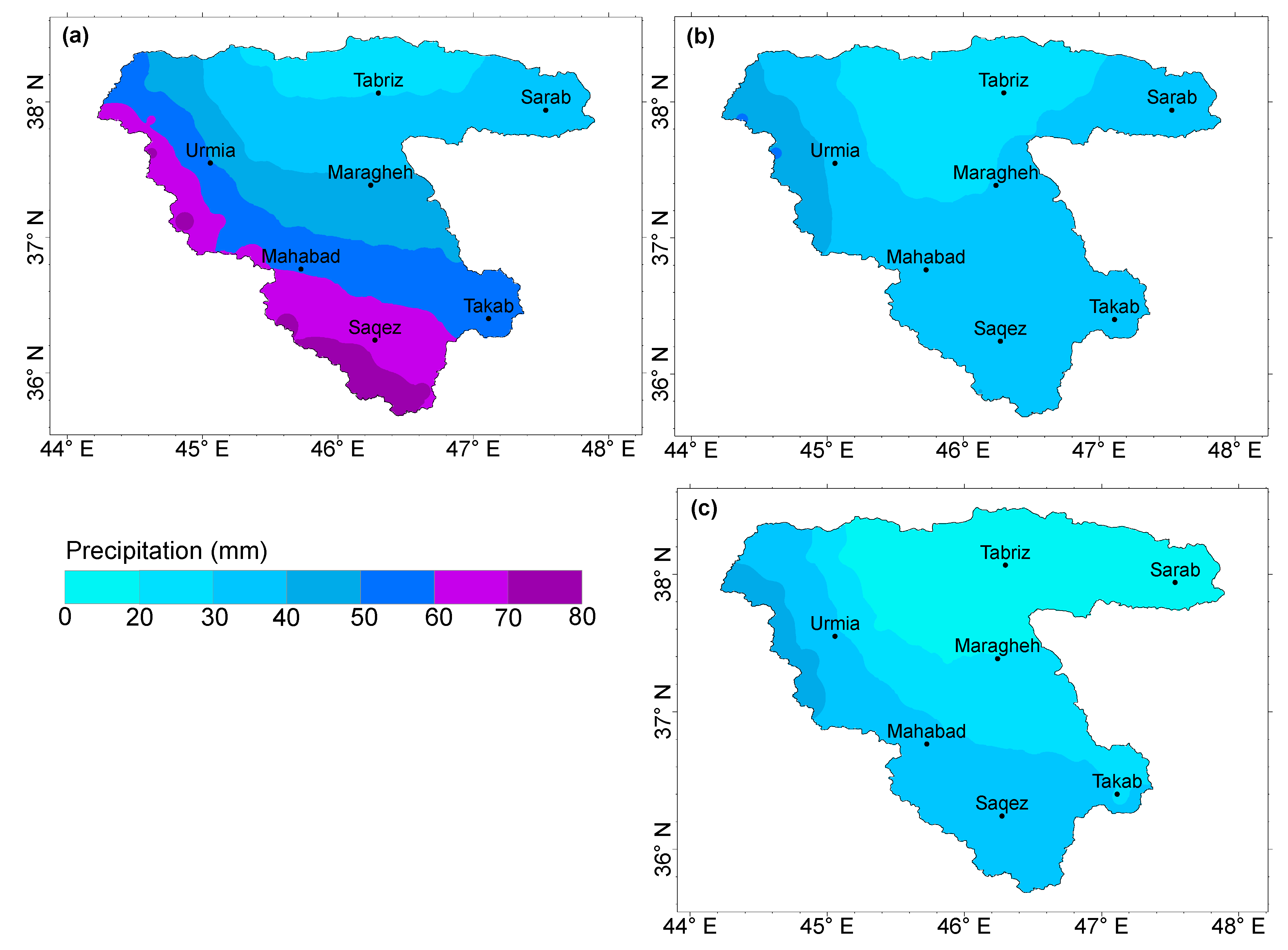
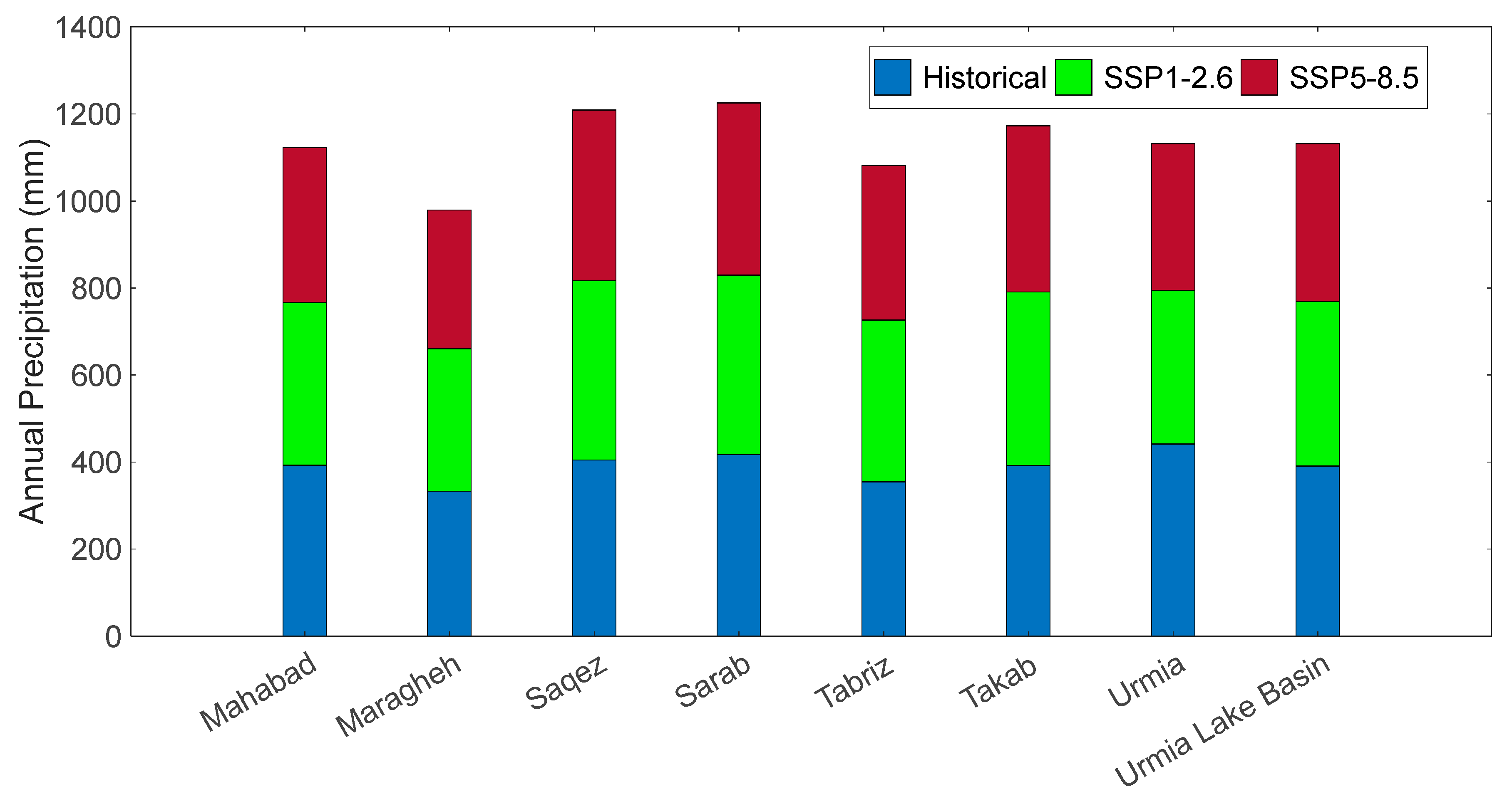
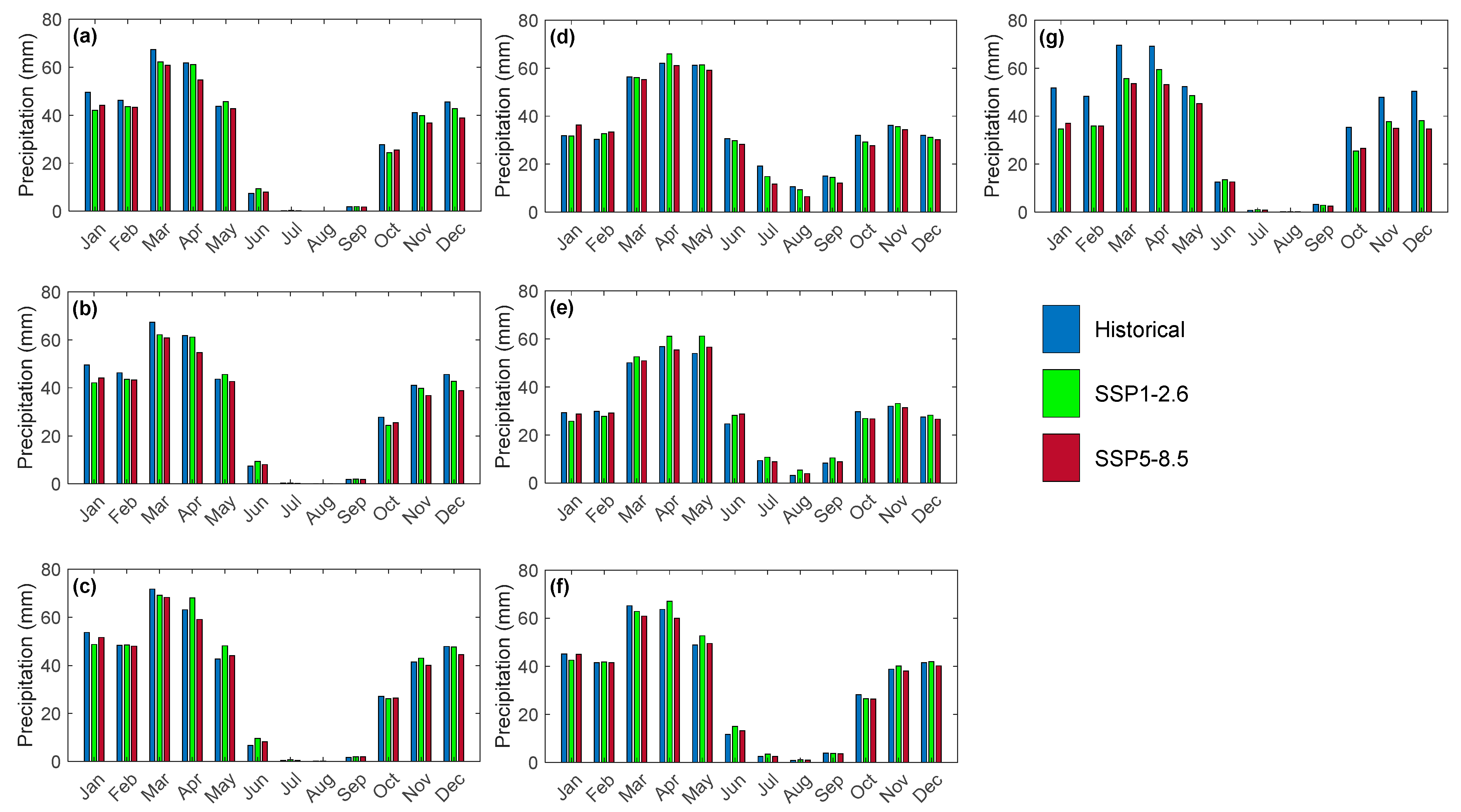
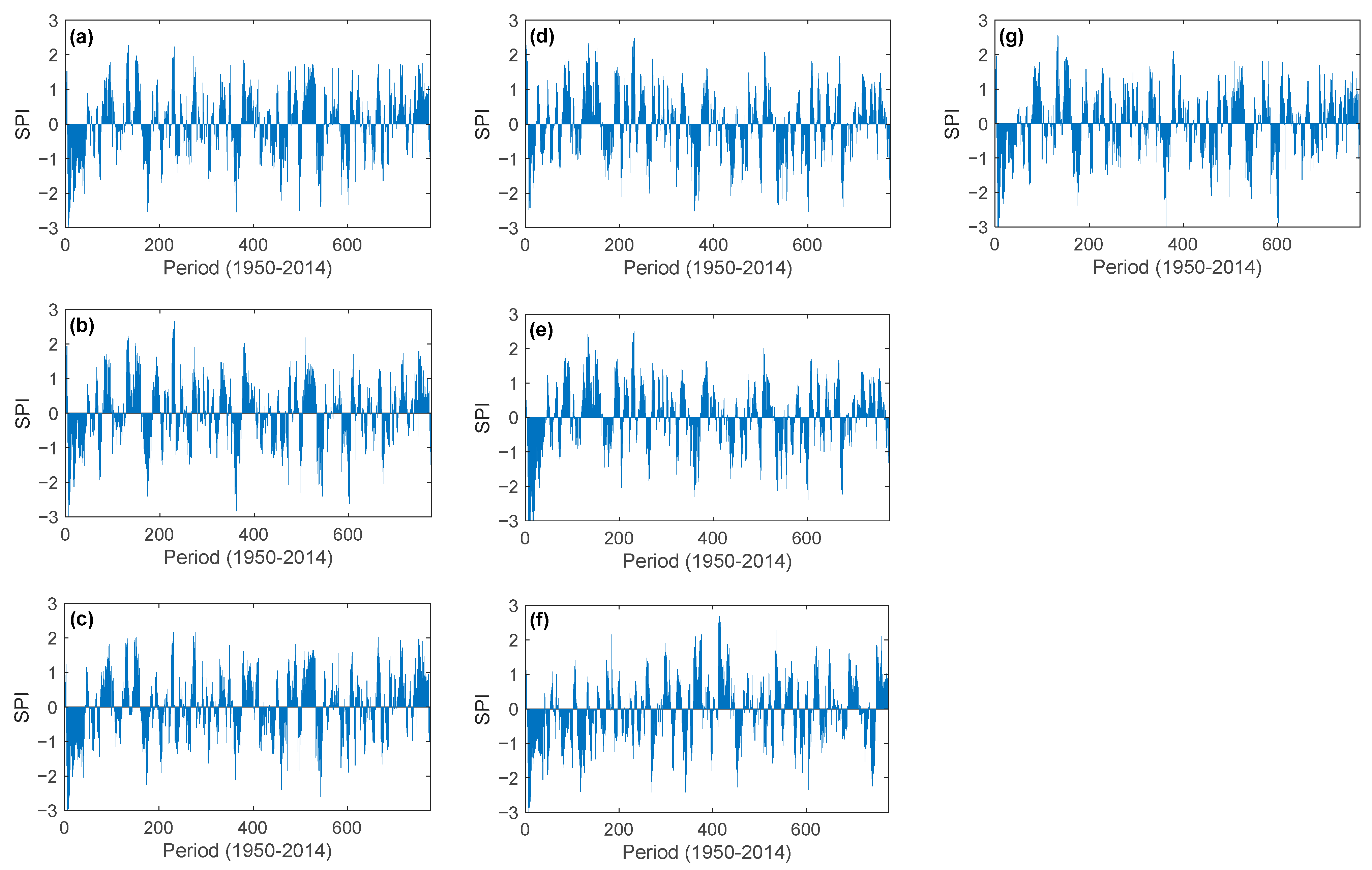
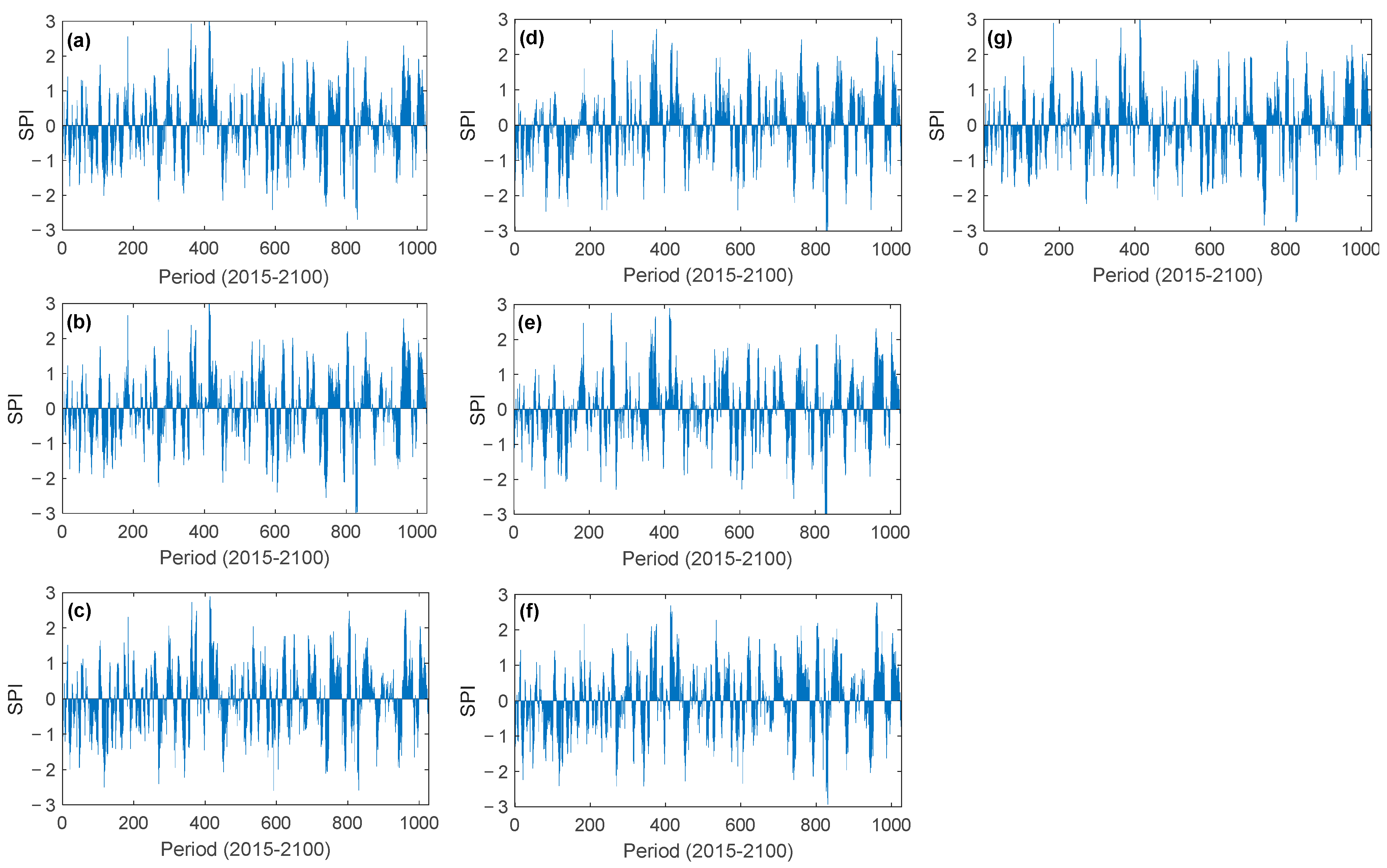
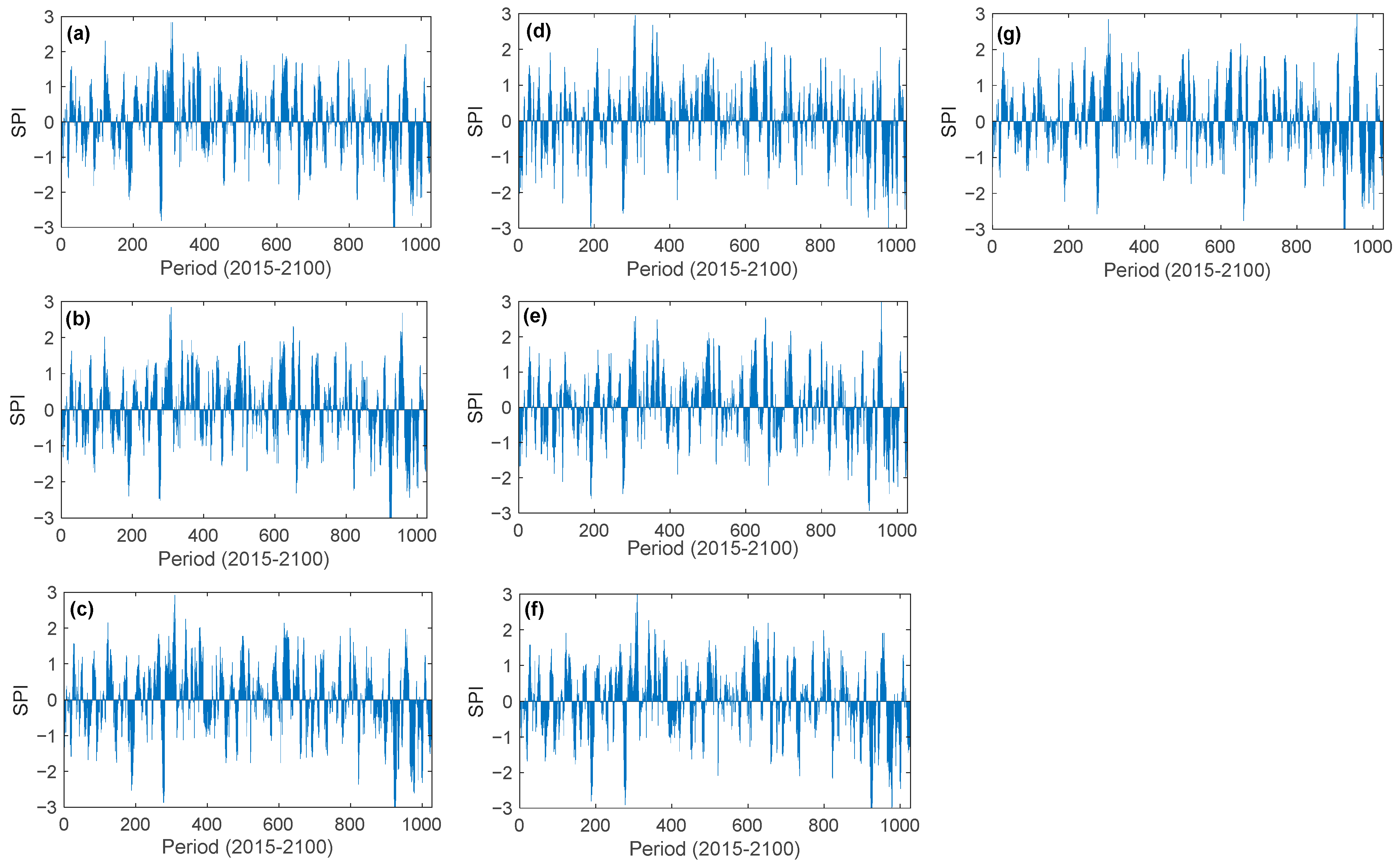

| (No.) Name | Altitude (m) | Annual Precipitation (mm) | Latitude (N) | Longitude (E) |
|---|---|---|---|---|
| (1) Mahabad | 1352 | 390 | 36.75 | 45.71 |
| (2) Maragheh | 1344 | 298 | 37.38 | 46.23 |
| (3) Saqez | 1523 | 409 | 36.22 | 46.27 |
| (4) Sarab | 1682 | 242 | 37.94 | 47.52 |
| (5) Tabriz | 1364 | 285 | 38.07 | 46.28 |
| (6) Takab | 1364 | 308 | 36.39 | 47.10 |
| (7) Urmia | 1328 | 325 | 37.54 | 45.07 |
| Model No. | Model Name | Research Institute and Country | Data Resolution |
|---|---|---|---|
| 1 | ACCESS-ESM1-5 | Australian Community Climate and Earth System | 0.25 × 0.25 |
| 2 | BCC-CSM2-MR | Beijing Climate Center China Meteorological Administration | 0.25 × 0.25 |
| 3 | CanESM5 | Canadian Centre for Climate Modelling and Analysis | 0.25 × 0.25 |
| 4 | EC-Earth3 | EC—EARTH consortium | 0.25 × 0.25 |
| 5 | GFDL-ESM4 | Geophysical Fluid Dynamics Laboratory | 0.25 × 0.25 |
| 6 | KACE-1-0-G | National Institute of Meteorological Sciences/Korea Meteorological Administration, Climate Research Division | 0.25 × 0.25 |
| 7 | KIOST-ESM | Korea Institute of Ocean Science and Technology | 0.25 × 0.25 |
| 8 | MIROC6 | Japan Agency for Marine–Earth Science and Technology, Atmosphere and Ocean Research Institute | 0.25 × 0.25 |
| Color | SPI Class | Values |
|---|---|---|
| Extremely wet | extremely wet | SPI ≥ 2.0 |
| Very wet | very wet | 1.50 ≤ SPI < 1.99 |
| Moderately wet | moderately wet | 1.00 ≤ SPI < 1.50 |
| Near normal | near normal | −0.99 ≤ SPI <1 |
| Moderately dry | moderately dry | −1.0 ≤ SPI < −1.50 |
| Severely dry | severely dry | −1.50 ≤ SPI < −2.0 |
| Extremely dry | extremely dry | SPI ≤ −2.0 |
| Mahabad | Maragheh | Saqez | Sarab | Tabriz | Takab | Urmia | |
|---|---|---|---|---|---|---|---|
| R-Square | 0.95 | 0.89 | 0.95 | 0.90 | 0.93 | 0.93 | 0.92 |
| RMSE | 5.03 | 6.56 | 6.85 | 5.23 | 6.15 | 8.64 | 5.69 |
| SPI Category | Stations (1: Mahabad, 2: Maragheh, 3: Saqez, 4: Sarab, 5: Tabriz, 6: Takab, 7: Urmia) | |||||||||||||
|---|---|---|---|---|---|---|---|---|---|---|---|---|---|---|
| 1 | 2 | 3 | 4 | 5 | 6 | 7 | ||||||||
| SSP1-2.6 | SSP5-8.5 | SSP1-2.6 | SSP5-8.5 | SSP1-2.6 | SSP5-8.5 | SSP1-2.6 | SSP5-8.5 | SSP1-2.6 | SSP5-8.5 | SSP1-2.6 | SSP5-8.5 | SSP1-2.6 | SSP5-8.5 | |
| Extremely wet | 20 | 7 | 20 | 10 | 23 | 10 | 25 | 15 | 21 | 15 | 22 | 8 | 17 | 14 |
| Very wet | 48 | 62 | 52 | 47 | 48 | 51 | 42 | 48 | 49 | 59 | 45 | 43 | 66 | 56 |
| Moderately wet | 110 | 106 | 103 | 125 | 98 | 104 | 91 | 80 | 101 | 93 | 94 | 113 | 91 | 111 |
| Near Normal | 678 | 690 | 685 | 680 | 682 | 698 | 701 | 713 | 688 | 688 | 689 | 699 | 689 | 694 |
| Moderately dry | 109 | 92 | 102 | 94 | 114 | 90 | 88 | 89 | 100 | 103 | 102 | 90 | 101 | 91 |
| Severely dry | 42 | 36 | 42 | 41 | 44 | 42 | 54 | 46 | 46 | 42 | 55 | 40 | 45 | 36 |
| Extremely dry | 19 | 33 | 22 | 29 | 17 | 31 | 25 | 35 | 21 | 26 | 19 | 33 | 17 | 24 |
Disclaimer/Publisher’s Note: The statements, opinions and data contained in all publications are solely those of the individual author(s) and contributor(s) and not of MDPI and/or the editor(s). MDPI and/or the editor(s) disclaim responsibility for any injury to people or property resulting from any ideas, methods, instructions or products referred to in the content. |
© 2023 by the authors. Licensee MDPI, Basel, Switzerland. This article is an open access article distributed under the terms and conditions of the Creative Commons Attribution (CC BY) license (https://creativecommons.org/licenses/by/4.0/).
Share and Cite
Ghazi, B.; Dutt, S.; Torabi Haghighi, A. Projection of Future Meteorological Droughts in Lake Urmia Basin, Iran. Water 2023, 15, 1558. https://doi.org/10.3390/w15081558
Ghazi B, Dutt S, Torabi Haghighi A. Projection of Future Meteorological Droughts in Lake Urmia Basin, Iran. Water. 2023; 15(8):1558. https://doi.org/10.3390/w15081558
Chicago/Turabian StyleGhazi, Babak, Sanjana Dutt, and Ali Torabi Haghighi. 2023. "Projection of Future Meteorological Droughts in Lake Urmia Basin, Iran" Water 15, no. 8: 1558. https://doi.org/10.3390/w15081558
APA StyleGhazi, B., Dutt, S., & Torabi Haghighi, A. (2023). Projection of Future Meteorological Droughts in Lake Urmia Basin, Iran. Water, 15(8), 1558. https://doi.org/10.3390/w15081558







